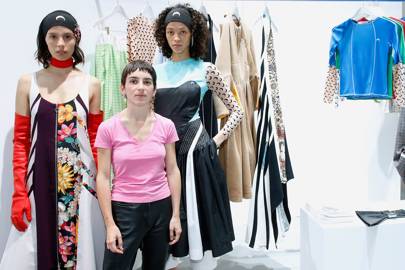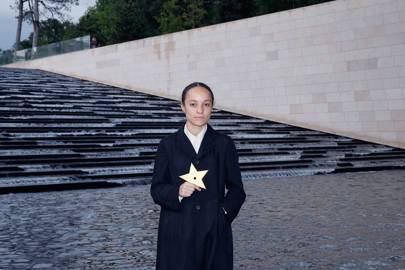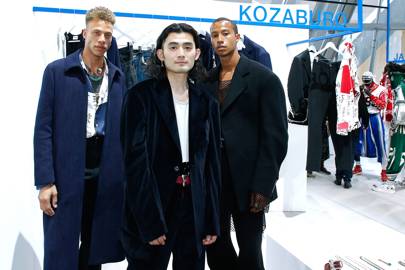In reality, it’s less of a fairy tale and more of a cautionary tale. For, as every young designer knows, the challenges of establishing an independent label can make it almost impossible to do, even with financial support, chattering buzz and thousands of Instagram likes. One could even argue that the spotlight is a deterrent to real sustainable growth and brand building. For every success story, there is a defunct label that once showed early promise.
The LVMH Prize is the brainchild of Louis Vuitton executive vice president Delphine Arnault. It’s open to designers under the age of 40 who have produced at least two collections. The winner receives €300,000, plus a year of mentorship from LVMH and its network. It also offers a runner-up Special Prize of €150,000 and similar mentorship opportunities. Thanks to the prominence of its sponsor and the eminence of its jury — a pantheon of the conglomerate’s star designers such as Karl Lagerfeld, Nicolas Ghesquièreand Marc Jacobs — the Prize has quickly established itself as one of the most prestigious and valuable contests in the world for young fashion designers. This year, more than 1,300 designers representing 90 nationalities applied.
Of its winners, many have gone on to become the most exciting names on fashion week schedules — Marques Almeida, Wales Bonner, Marine Serre, Jacquemus, to name just a few — and even others who haven’t won have gone far. Virgil Abloh, for instance, was merely a finalist in 2015 — three years later, he’s the new artistic director of menswear for Louis Vuitton.

So what makes this prize so special? “You’re being judged by designers,” says Marta Marques, one half Marques Almeida, which won the LVMH Prize in 2015 and has since established itself as a steadily thriving business. “To speak to them about the struggle of creating a brand, and balancing the creative and business sides — you don’t get that with any other prizes, and that helped us with cementing where we were going.” Marques points out that what also set the award apart was the mentorship from Sophie Brocart, senior vice president of LVMH’s fashion ventures and CEO of Nicholas Kirkwood. “To have that huge level of expertise on the other end of a phone call or email was really precious. We could bring expert knowledge to the fields that weren’t our strong point.”
“I wouldn’t have been able to carry on without winning it,” says Grace Wales Bonner. The London-based menswear designer won the LVMH Prize in 2016 and is now one of the star attractions at London Fashion Week Men’s. “It gave me security to build the foundations of what I wanted to do and the support to strategise and consider,” she adds, also mentioning that the process gave her a much-needed confidence boost.
Part of the success of the LVMH Prize is how it has rejuvenated the conglomerate, which had experienced its own scandal (Galliano-gate!) and an increasingly spinning carousel of creative directors. By aligning itself with the patronage of a younger generation — just as Topshop once did by sponsoring the British Fashion Council’s NewGen scheme — the company attracts positive publicity and creates an association with fresh, new talent.
Despite the prestige, however, some critics question just how sustainable the prize is for a generation of designers who are starting businesses at a time when the traditional retail and wholesale model is in flux — especially as most of the jury is more familiar with the conventional fashion system. “Design isn’t what makes a fashion brand today — and they need to reward the most progressive view,” luxury brand strategist Ana Andjelic says of the prize. “The question is: how do you use this prize to make something more sustainable? Of course, you can do a fashion show and do wholesale, but do you really want to start your career by being 50 percent off at Nordstrom?”

Andjelic has a point. Whereas prizes in other industries recognise innovation and disruption, fashion has a tendency to stick to what it knows — Karl Lagerfeld, for instance, famously boasts that he doesn’t interact with marketing executives in his work for Fendi and Chanel. Today’s designers require an arsenal of skills that range from direct-to-consumer e-commerce and digital marketing to brand content and sustainable production. She continues: “Once you’re in the LVMH Prize, you’re in the fashion system. We are now questioning whether seasonality even makes sense anymore, so we need mentors from different industries, and to take the prize further and make LVMH work harder for these designers.”
Winning the Prize does not automatically guarantee success. Thomas Taitand Hood By Air, both winners in 2014, are no longer producing collections. Although Hood By Air’s Shayne Oliver has made a successful transition into a freelance career by designing one-off collections for Helmut Lang and Diesel, Tait is admonitory of why fashion prizes can be a blessing and a curse.
Before winning the inaugural LVMH Prize, Tait struggled with the battle of putting on a show in September and only being able to pay for materials in August, when most Italian factories are closed, which allowed him just a few days to create an entire ready-to-wear collection. “To some people [€300,000] might seem like an enormous amount of money, to some people it could seem like something that could go overnight,” Tait told me in 2015, less than a year after winning the Prize and months before he would quit the catwalk.
“There’s a lot of people who have this false idea that you’ll be fine – just keep it up for a few years and somebody’s going to hand you a creative director’s position,” he added. “That might not happen. The sensationalism of fashion creates this false sense of comfort where people think that you can really get yourself into a huge financial mess and then some kind of magic trick is going to clear out all the debt and you’ll become a big star.”
“I wouldn’t have been able to carry on without winning it,” says Grace Wales Bonner. The London-based menswear designer won the LVMH Prize in 2016 and is now one of the star attractions at London Fashion Week Men’s. “It gave me security to build the foundations of what I wanted to do and the support to strategise and consider,” she adds, also mentioning that the process gave her a much-needed confidence boost.
Part of the success of the LVMH Prize is how it has rejuvenated the conglomerate, which had experienced its own scandal (Galliano-gate!) and an increasingly spinning carousel of creative directors. By aligning itself with the patronage of a younger generation — just as Topshop once did by sponsoring the British Fashion Council’s NewGen scheme — the company attracts positive publicity and creates an association with fresh, new talent.
Despite the prestige, however, some critics question just how sustainable the prize is for a generation of designers who are starting businesses at a time when the traditional retail and wholesale model is in flux — especially as most of the jury is more familiar with the conventional fashion system. “Design isn’t what makes a fashion brand today — and they need to reward the most progressive view,” luxury brand strategist Ana Andjelic says of the prize. “The question is: how do you use this prize to make something more sustainable? Of course, you can do a fashion show and do wholesale, but do you really want to start your career by being 50 percent off at Nordstrom?”

Andjelic has a point. Whereas prizes in other industries recognise innovation and disruption, fashion has a tendency to stick to what it knows — Karl Lagerfeld, for instance, famously boasts that he doesn’t interact with marketing executives in his work for Fendi and Chanel. Today’s designers require an arsenal of skills that range from direct-to-consumer e-commerce and digital marketing to brand content and sustainable production. She continues: “Once you’re in the LVMH Prize, you’re in the fashion system. We are now questioning whether seasonality even makes sense anymore, so we need mentors from different industries, and to take the prize further and make LVMH work harder for these designers.”
Winning the Prize does not automatically guarantee success. Thomas Taitand Hood By Air, both winners in 2014, are no longer producing collections. Although Hood By Air’s Shayne Oliver has made a successful transition into a freelance career by designing one-off collections for Helmut Lang and Diesel, Tait is admonitory of why fashion prizes can be a blessing and a curse.
Before winning the inaugural LVMH Prize, Tait struggled with the battle of putting on a show in September and only being able to pay for materials in August, when most Italian factories are closed, which allowed him just a few days to create an entire ready-to-wear collection. “To some people [€300,000] might seem like an enormous amount of money, to some people it could seem like something that could go overnight,” Tait told me in 2015, less than a year after winning the Prize and months before he would quit the catwalk.
“There’s a lot of people who have this false idea that you’ll be fine – just keep it up for a few years and somebody’s going to hand you a creative director’s position,” he added. “That might not happen. The sensationalism of fashion creates this false sense of comfort where people think that you can really get yourself into a huge financial mess and then some kind of magic trick is going to clear out all the debt and you’ll become a big star.”

There’s also the question of whether a younger generation of designers covet those creative directorships, which were once seen as the holy grail for lesser-known names. “I think now that everything is so fickle and contracts are so short, it’s not something that is desirable in terms of job stability because everyone is getting hired and then quitting or being fired,” says Vejas Kruszewski, who won the Special Prize in 2016 and has recently put his label on hold to work on Pihakapi, a project with Italian leather manufacturer Pellemoda that allows him to bypass many of the challenges that young designers face. “You go into a situation where all the infrastructure you need is in place, but the downside is that you have to deal with corporate process and all the numbers.”
For many young designers straight out of college, negotiating the relationships with manufacturers, publicists, sales agents and distributors can be hard to manage. It can also lead to overwhelming overheads, which affect pricing and make it difficult to position one’s label in a competitive marketplace. “I’m based in New York and do production in Japan and show in Paris, so my challenge is always a lot to do with budgets and the cash flow,” says Kozaburo Akasaka, who won the Special Prize last year. “I need to keep doing that unless I have more people and there’s also the issue of quality control as you want a certain level of craftsmanship for the product — especially as if you can afford to order more materials, you get a better price.” As a result, pricing can be somewhat skewed. One of Akasaka’s exquisite handmade coats, for example, retails for $2,000 - a price which can prevent younger consumers buying into the brand.
There is, however, a new outlook on the horizon. Marine Serre won the LVMH Prize last year and is the first winner not to hail from Central Saint Martins. The prize enabled her to find a studio that wasn’t her bedroom and to employ a few people to help her and start creating a collection made from upcycled materials that would be shown at Paris Fashion Week. “For me, luxury is not a €7,000 dress,” says Serre, adding that she wanted to start her label with accessible prices and alternative methods of circular production. “I knew I wanted it to be recycled deadstock materials and the other solution is not trying to develop 45 prints and cancel 25. I had nothing cancelled in my last collection and I produced everything.” She’s already developed a full line of accessories — ball-shaped bags, silk-scarf earrings, crescent-moon jersey sock boots — that is being snapped up by several of the international retailers who are already selling her label, which was only officially started eight months ago.
“It wasn’t something I was planning to do,” adds Serre. “I wanted to have a brand but I didn’t think it would happen tomorrow.” The challenge for her now will be turning overnight success into a lifelong career. By the look of things, however, she’s already one step ahead.
“It wasn’t something I was planning to do,” adds Serre. “I wanted to have a brand but I didn’t think it would happen tomorrow.” The challenge for her now will be turning overnight success into a lifelong career. By the look of things, however, she’s already one step ahead.

No comments:
Post a Comment